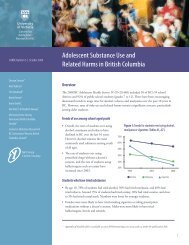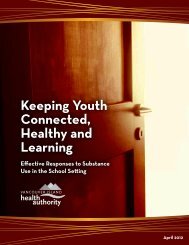A Review Of Research Into The Impacts Of Alcohol ... - CARBC
A Review Of Research Into The Impacts Of Alcohol ... - CARBC
A Review Of Research Into The Impacts Of Alcohol ... - CARBC
You also want an ePaper? Increase the reach of your titles
YUMPU automatically turns print PDFs into web optimized ePapers that Google loves.
that poses health risks (e.g. ICAP, 1997). <strong>The</strong> recent major<br />
WHO Global Burden of Disease study developed a measure<br />
of the extent to which different health risk behaviours reduced<br />
both life expectancy and quality of life, known as Disability<br />
Adjusted Life Years or DALYs. Rehm and Room (2005) report<br />
that tobacco is estimated to contribute 4.1% of the total burden<br />
of premature death or disability in the year 2000, and alcohol<br />
4% of the same total. While it may seem surprising that alcohol<br />
contributes almost exactly the same amount of death and<br />
disability as does tobacco, this is because, while tobacco tends<br />
to take a few years off the life of a large number of older people,<br />
alcohol impacts on mostly younger people who have many more<br />
years of life to lose. <strong>The</strong> second argument that it is only tobacco<br />
which can harm health in even small doses in fact also applies<br />
to alcohol since, in relation to cancer risk, there is no known<br />
safe level of alcohol consumption (Chikritzhs et al, 2002). <strong>The</strong><br />
complication, of course, concerns the widely accepted health<br />
benefits of light to moderate alcohol consumption, which in<br />
most current estimates appear to somewhat outweigh the<br />
negative effects. For example, Chikritzhs et al (2003) estimated<br />
that for Australia in 2000, low-risk alcohol consumption was<br />
associated with 2,050 deaths but also prevented as many as<br />
6,193, i.e. resulting in a net benefit of 4,143 deaths prevented.<br />
Most of the deaths from low-risk consumption were related to<br />
cancer. It could be argued that even the small but significant risk<br />
of cancer at even low levels of consumption is worth advising<br />
consumers about.<br />
<strong>The</strong> submission by Spirits Canada on Bill C-206 also mentions<br />
a number of other arguments against the introduction of alcohol<br />
warning labels. <strong>The</strong> submission emphasises evidence of alcoholrelated<br />
road crashes being on the decline, and also the small<br />
number of people who drink and drive, who drink at risky levels<br />
during pregnancy, or who drink in a way liable to put their<br />
health at risk. <strong>The</strong> recent report on the results of the Canadian<br />
Addictions Survey (or CAS, Adlaf et al, 2005) nonetheless<br />
indicates that 30% of male and 15% of female drinkers have<br />
exceeded low-risk drinking guidelines for long-term harm, while<br />
higher proportions put themselves at risk of acute harm by<br />
heavy drinking sessions at least once a month (34% males, 17%<br />
females). Spirits Canada notes that over 50% of pregnancies are<br />
unplanned, and it is clear from CAS results that women of childbearing<br />
age are especially likely to consume alcohol in a risky<br />
fashion. <strong>The</strong> highest risk time for damage to the foetus is during<br />
the first month after conception, when women do not know they<br />
are pregnant. It is likely, therefore, that a high proportion of the<br />
population may benefit from being reminded of the health and<br />
safety risks of alcohol consumption.<br />
Specifically in relation to Bill C-206, the proposed legislation<br />
for alcohol warning labels for Canada is very similar to<br />
that currently in place in the United States. On the basis<br />
of the evidence reviewed here, it could be expected that the<br />
introduction of such labels would be noticed by most drinkers<br />
and especially by young and high-risk drinkers. Furthermore,<br />
it could be expected that, initially at least, these labels would<br />
trigger informal discussions about the health consequences of<br />
alcohol consumption. It is also likely that the already high levels<br />
of public support for warning labels in Canada would further<br />
increase in the years following their introduction. It is possible<br />
that the labels might prompt some women who are already<br />
light drinkers to drink slightly less when they are pregnant. It<br />
is also possible that seeing the labels might discourage a few<br />
people from driving after drinking. It is unlikely, however, in<br />
the absence of a wide range of other strategies to encourage<br />
Canadians to engage in safer alcohol use, that the warning labels<br />
would on their own result in an overall reduction in hazardous<br />
alcohol consumption or specific risk behaviours such as drinking<br />
and driving.<br />
<br />
Centre for Addictions <strong>Research</strong> of BC





